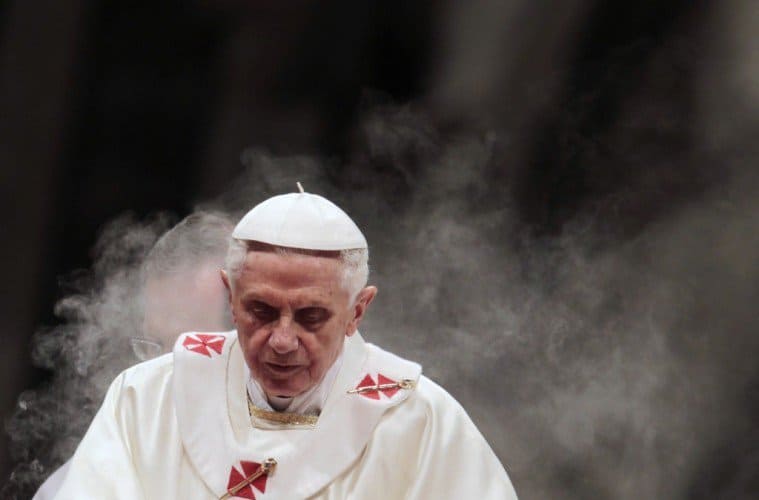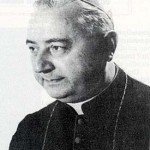If you were to walk up to your everyday Catholic on the street and ask, “Who was Annibale Bugnini?” You’d probably elicit some interesting answers. “An Italian film director?” or perhaps “A fashion designer?” or maybe, “Who was who?” or just the classic deer in the headlights stare. It’s a curious thing because, without knowing anything about the man, many Catholics live their Sunday-to-Sunday liturgical lives within the context of a legacy Bugnini (1912-1982) meticulously built. He was, according to noted liturgist and close associate of Benedict XVI, Monsignor Nicola Bux, the “real architect of the liturgical reform” of the late 1960s. (Read Benedict XVI’s Reform: The Liturgy Between Innovation and Tradition.) In fact, Bugnini once boldly, and somewhat creepily proclaimed, “I am the liturgical reform!” Narcissism aside, he wasn’t far off.
Within very contained Catholic circles, much ink has been spilled on Bugnini’s toxic influence, lambasting the machinations of a man who was singularly obsessed with the transformation (I would argue deconstruction) of the traditional Roman Liturgical Rite. But that spilled ink hasn’t seeped into the collective consciousness of most Catholics, whose apathy insulates them, but who nevertheless live unknowingly in Bugnini’s universe. Bugnini cunningly used the benign pretext of ecumenism as the rationale to marshal his bold plan forward. Stating that a demystified, minimalistic liturgy would better appeal to our Protestant brethren, he forced reforms that, if not fundamentally, then radically changed the makeup of the Church’s liturgy. He famously declared that “We must strip from our … Catholic liturgy everything which can be the shadow of a stumbling block for our separated brethren, that is, for the Protestants.” What is often overlooked, intentionally or unintentionally, is the fact that these reforms of the late 1960s took place years after the conclusion of the Second Vatican Council, and were not directly related to any of the Council’s statements on liturgy, as found in Sacrosanctum Concilium. Again, to quote from Bux,
So, reform has become synonymous with transformation and change. This is supposed to be what was done by the Council! But in fact, it did not do this. Nevertheless, the Council is blamed by all those who make changes to the rite according to their own pleasure, despite the Constitution on the Liturgy’s exhortation, “Therefore no other person, even if he be a priest, may add, remove, or change anything in the liturgy on his own authority”.
Think about that for a second.
This injunction has not prevented liturgical jacobins, heirs to Bugnini’s legacy, from using the “Spirit of Vatican II” as a dark cover to insert any number of innovations and abuses into the liturgy. “Vatican II man! So why not dancing, prancing gals in leotards and rock bands??” What we’ve seen is not only an assault on liturgy, but an assault on the Second Vatican Council! And that’s a big deal. Who hasn’t heard, “Vatican II changed that.” Well, no actually, it didn’t.
Annibale Bugnini first appeared on the Vatican scene under the pontificate of Pius XII. This is somewhat ironic, given Pius’ strong liturgical sense. Working his way up the ladder of various Vatican commissions, he temporarily fell from grace under Pope John XXIII but was soon rehabilitated by Pope Paul VI who, later in his pontificate, rather suddenly and unceremoniously sent Bugnini packing to a low-level post in Iran. Questions about the circumstances surrounding Bugnini’s final fall from pontifical graces remain but by then, the damage had been done, the seed of his liturgical vision had been planted and taken root.
In many ways, Bugnini accomplished his goals. Who needs garish marble monuments in your honor when you can point to an entire culture as your legacy in which millions marinate, week after week, year after year? And while he failed in achieving his ultimate objective, the complete abolition of the Tridentine Mass (thank God!), he successfully waged guerilla war against the Novus Ordo liturgy, which is what the overwhelming majority of Catholics today experience on Sundays. Like a miner who tirelessly and surreptitiously burrows beneath and weakens an enemy’s above-ground fortifications, Bugnini campaigned relentlessly to eliminate or dilute many of the traditional elements of the liturgy: ancient prayers, rites, vestments, etc., with the end result being an almost unrecognizable liturgy. How could this have happened? Why didn’t anyone stop him? These are inescapable, stubborn questions. While there were several prelates who raised red flags, like Cardinal Alfredo Ottaviani, much of the Church’s leadership was understandably preoccupied with the goings on in the culture wars and the societal spasms of the late 1960s. Of course, Pope Paul VI’s Humanae Vitae comes to mind. (Written with the help of a brilliant Polish Cardinal named Karol Wojtyla, this document faced relentless opposition inside and outside the Church, which exacted a severe toll on Paul VI’s strength.) Sensing opportunity, Bugnini, with the assistance of loyal disciples in the Church like Milwaukee’s very own Rembert Weakland, took advantage of these fierce external battles to achieve his liturgical victories. (In many respects, Milwaukee remains Bugnini’s playground when it comes to out-of-control liturgical aberrations.)
Many Catholics don’t know about Bugnini, and they don’t care to. In a way, that’s fine with me. I pray for the repose of his soul, but we shouldn’t give him a pass on the chaos he unleashed within the liturgy, which spread like destabilizing ripples on the surface of a once-calm lake. (An interesting aside: Archbishop Piero Marini, Bugnini’s ever-loyal student for years, became the Master of Pontifical Ceremonies under Pope John Paul II where, for over twenty years, he oversaw the Bugnini-zation of many a Pontifical liturgies.) That said, for all the damage Bugnini unleashed, one thing he probably didn’t anticipate was the ascendancy of one man who could foil all his life’s work. His name? Benedict XVI.
If we had checked, Bugnini may have turned over somewhat on April 19, 2005 when the name “Ratzinger!” sounded from the central loggia of Saint Peter’s Basilica. (I was living in Rome at the time and was in the piazza, in the front row of an enormous crowd. The excitement among young Catholics over Ratzinger’s elevation was electrifying.) The author of The Spirit of the Liturgy, a book which basically demolishes, brick by brick, Bugnini’s and the School of Bologna’s read on Vatican II and liturgy, was sitting in the Chair of Peter. Sound the alarm! As Pope, Benedict XVI finally sent Archbishop Piero Marini packing, installing a far more traditional-minded, younger liturgist, Monsignor Guido Marini (no relation to Piero Marini). He continues to work in this post under Pope Francis, a telling sign.
One of Pope Benedict’s greatest gifts to the Church, and there were many, was his liturgical sense. As Kenneth Wolfe observed a number of years back in The New York Times, in Pope Benedict, Bugnini “finally met his match.” This “humble worker in the Lord’s vineyard” was the perfect antidote to the au courant plague of clerical narcissism embodied by Bugnini and his followers. This shy, yet brilliant Renaissance man of a Pope “got” liturgy in a way that even many of the more recent Popes didn’t. It is fair to say that he has dedicated his life to the liturgy. Contrary to the theory of rupture and discontinuity pushed by Bugnini, Benedict set in motion a true reform of the liturgy, one rooted in continuity and tradition, in other words, what the Second Vatican Council, and even Pope Pius XII, called for from the get-go.
Benedict’s papacy and liturgical vision were not reactionary. It would do him an injustice to define his refined liturgical sense and vision as merely a reaction to someone like Bugnini or Weakland. Benedict is truly a colossus in the Church’s history, and the aforementioned prelates are forgotten footnotes. Let’s be honest, Benedict could not change things overnight. There was no switch to flip that would automatically undo all of Bugnini’s machinations, and a forty-year period of chaos. But, just as Bugnini planted his seed of revolution, Benedict planted his seed of true reform and beauty. Holiness, prayer and patience are required to see this one through. With God’s help and in His time, it will happen.
* (Pope Benedict photo: Reuters/Alessandro Bianchi)




